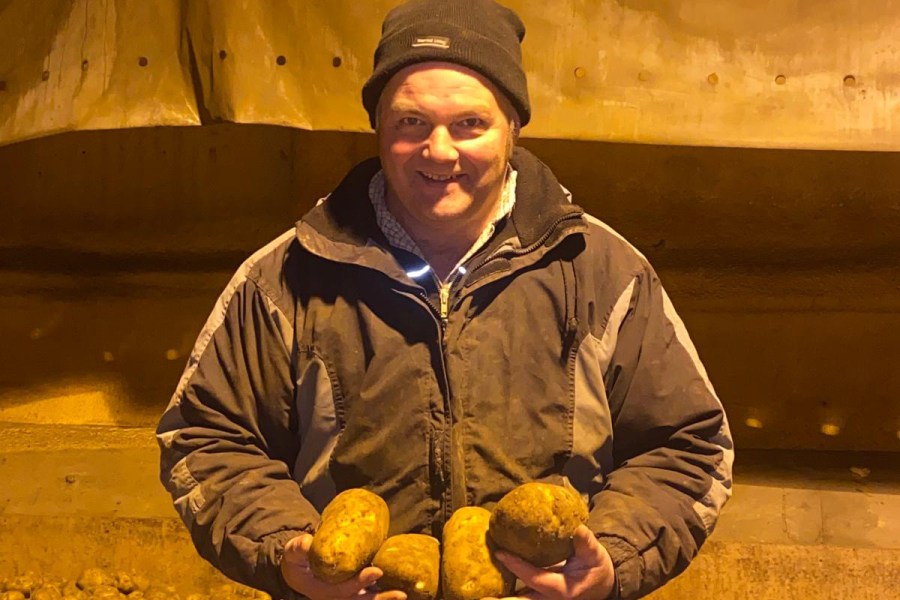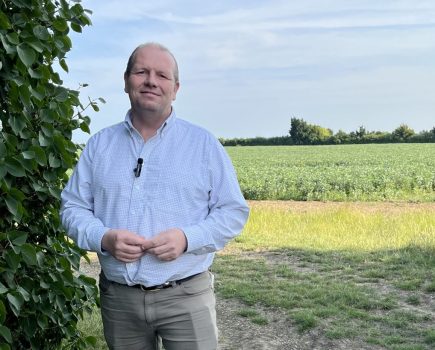by Andrew Wilson
A memory popped up on my social media recently from back in 2011. It was a simple post wishing for rain – father had seen one of our neighbours irrigating cereals and had come home with aspirations of similar activities.
Economics were a little different even as recently as 2011, but I’m hoping said reminiscence is a good omen – 2011 was one of our best potato years in my 30 years growing them! Optimism in this job is essential…
As I write this, we’re finishing planting our 2025 crop. We’ve had our challenges as ever but it’s been easy as far as weather is concerned – soil was warming up by the time we started and we’ve managed to not let anything bake out.
One field took a little more patience and fuel than the others and was notably the only one without a cover crop on it during winter. Coincidence? I think not – despite our covers looking pretty poor on the surface, the important work is done underneath, and it’s been refreshing to cultivate less than usual. The bulk being done by an old shakerator with a Metcalfe leg conversion, and a Simba TL cultivator.
The plough and bedtiller have been out of the shed too but haven’t done a huge area. My policy is as little as possible but as much as necessary, when it comes to cultivation. Retaining moisture has been key – usually we’re trying to dry land out.
This season has seen a few firsts, broiler litter being one of them. I was after something to give our crops some get up and go, and following research and a good local contact, we made it happen. This may be something we use strategically in our rotation as well as in potatoes if we can get a few practical details polished up.
We’ve made a few tweaks to in-furrow encouragements aimed mostly at root health and rhizoctonia defence. We’ve meddled with things like destoner pitch a few times during the years but always come back to 42mm, and aim to not overwork soil to a point where the cross conveyor runs empty in a bid to enhance row structure without creating bother for the harvester.
Seed is an area we have little control over. Generally seed destined for chitting comes to us in February, we treat it if necessary and crate it up with an aim of physiologically aging it by c.250 day degrees by the time it’s planted.
This year being early, it just about hit 200 day degrees, but went into the ground with a 3mm chit in good order. The remainder of seed usually arrives a month or so later and is decanted into tonne boxes, but this year we’ve had to resize some of our stock.
Technology is inevitable, but sometimes, just occasionally, the old ways are the best. I’ve no wish to dust the old sippit off, but screen sizing potatoes has worked perfectly well for longer than I’ve been on the earth.
Our last field planted has seen a flurry of acronyms in action. VESS and STIR have been calculated, and EiQ, alongside fuel use, carbon footprint, resource utilisation and yield versus inputs calculated will follow in due course. We’re ankle-deep in nature-friendly potatoes to the next level on this particular farm. We’re pushing the boundaries on a small area with companion plants and natural cover alternatives too. A step too far? We’ll see!
In other news, spring corn mostly looks decent albeit thirsty, and I’m pleased I pushed on sowing when I did, and that I applied its fertiliser immediately pre-drilling. This was to incorporate it into the seedbed with the drill and minimise volatilisation, even though it was cold at the time. I was a little nervous when my tender spring barley was enduring a daily frost a month ago.
Some of my wheat isn’t quite as good looking and I can see an odd tuft of blackgrass appearing if I look hard enough.
As for beet, well it had as good a start as any beet crop we’ve sown, but drought and wind are clobbering it at the moment. Placed fertiliser still looks worth the hassle, but the companion crop? My agronomist isn’t convinced – his eyes noticeably rolled when he saw I’d relented and drilled about a third of my beet area with a light barley cover.
As the field is by the side of a popular public footpath, said cover has piqued the interest of a few locals, confirmed by a few ‘what’s happening in there then?’ questions at our village Mayday event recently. It’s nice people are interested in what we’re up to and good to talk farming with the public.
Slightly less positive is the beet futures price currently and the doldrum territory of the grain markets, but let’s not dwell on something that’s invariably not static for long in any position these days.
The next few weeks will see Dan’s induction, pre-harvest machinery maintenance, irrigation systems set up, pollinator strips sown, and some farm roads see the same ‘keep on top of the little jobs before they get big’ philosophy.
I’m also on with making a few drainage maps for fields where they’re absent, it’s not often drain lines are as visible as they are this year; was the last time 2011?
This article was taken from the latest issue of CPM.
For more articles like this, subscribe here.
Sign up for Crop Production Magazine’s FREE e-newsletter here.




